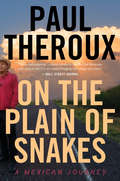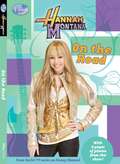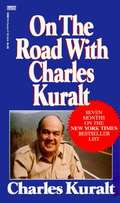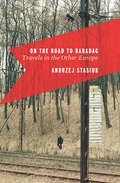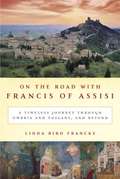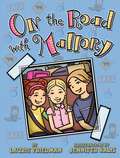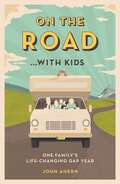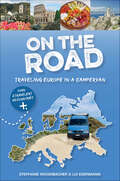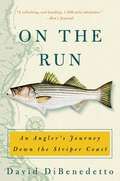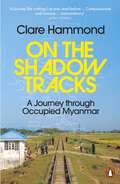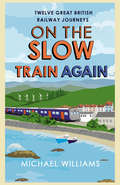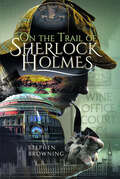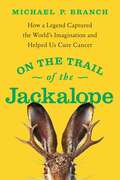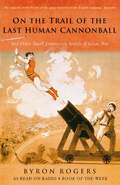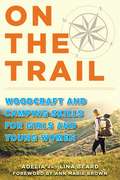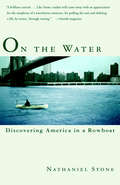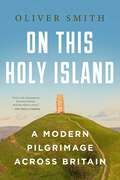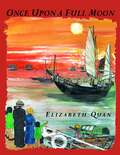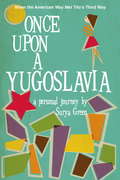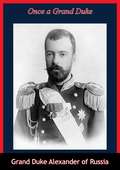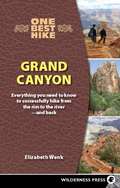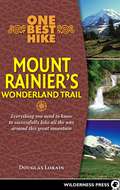- Table View
- List View
On the Pampas
by Maria Cristina BruscaAn account of a little girl's idyllic summer at her grandparents' ranch on the pampas of Argentina. Ages 7 and up.
On the Plain of Snakes: A Mexican Journey
by Paul TherouxLegendary travel writer Paul Theroux drives the entire length of the US–Mexico border, then goes deep into the hinterland, on the back roads of Chiapas and Oaxaca, to uncover the rich, layered world behind today’s brutal headlines. Paul Theroux has spent his life crisscrossing the globe in search of the histories and peoples that give life to the places they call home. Now, as immigration debates boil around the world, Theroux has set out to explore a country key to understanding our current discourse: Mexico. Just south of the Arizona border, in the desert region of Sonora, he finds a place brimming with vitality, yet visibly marked by both the US Border Patrol looming to the north and mounting discord from within. With the same humanizing sensibility he employed in Deep South, Theroux stops to talk with residents, visits Zapotec mill workers in the highlands, and attends a Zapatista party meeting, communing with people of all stripes who remain south of the border even as their families brave the journey north. From the writer praised for his “curiosity and affection for humanity in all its forms” (New York Times Book Review), On the Plain of Snakes is an exploration of a region in conflict.
On the Road (Disney's Hannah Montana #14)
by Kitty RichardsSeries Description: Miley Stewart looks like a regular girl-next-door, but when the lights go down, Miley is teen pop sensation Hannah Montana! Off stage, Miley wants her life to be as normal as possible, so only a few people know the truth about her dual identity. But keeping that secret is harder than Miley ever thought it would be. Hannah Montana #14: On the Road. Miley is totally disappointed! Her dad canceled Hannah Montana's European concert tour because she is flunking biology. But if she can ace her midterm, Hannah's tour is back on! Miley is determined to go to Europe, so she creates song and dance routines as study techniques for the test. Will Miley's preparations earn her an A, or will she be left singing the blues? Plus, when Miley's dad forbids her to travel alone for a Hannah Montana charity concert, she decides to take matters into her own hands-and goes anyway!
On the Road With Charles Kuralt
by Charles KuraltThe pages of ON THE ROAD tell us why Charles Kuralt is one of this nation’s best journalists. He is eloquent and understanding, refreshing and in-focus. Mr. Kuralt sets the scene, then steps aside and lets his subjects do the talking. The voices ring true. His stories give us glimpses into America that make us feel good about ourselves, no mean feat these days.
On the Road to Babadag: Travels in the Other Europe
by Michael Kandel Andrzej StasiukAndrzej Stasiuk is a restless and indefatigable traveler. His journeys take him from his native Poland to Slovakia, Hungary, Romania, Slovenia, Albania, Moldova, and Ukraine. By car, train, bus, ferry. To small towns and villages with unfamiliar-sounding yet strangely evocative names. "The heart of my Europe," Stasiuk tells us, "beats in Sokolow, Podlaski, and in Husi, not in Vienna." Where did Moldova end and Transylvania begin, he wonders as he is being driven at breakneck speed in an ancient Audi--loose wires hanging from the dashboard--by a driver in shorts and bare feet, a cross swinging on his chest. In Comrat, a funeral procession moves slowly down the main street, the open coffin on a pickup truck, an old woman dressed in black brushing away the flies above the face of the deceased. On to Soroca, a baroque-Byzantine-Tatar-Turkish encampment, to meet Gypsies. And all the way to Babadag, between the Baltic Coast and the Black Sea, where Stasiuk sees his first minaret, "simple and severe, a pencil pointed at the sky." A brilliant tour of Europe's dark underside--travel writing at its very best.
On the Road with Francis of Assisi: A Timeless Journey Through Umbria and Tuscany, and Beyond
by Linda Bird FranckeOn the Road with Francis of Assisi offers a unique and lively travelogue of parallel journeys: that of Francis of Assisi on his way to sainthood in the thirteenth century, and that of author Linda Bird Francke, who followed his path through the beauty of central and coastal Italy--and even on to Egypt. Francke tells the compelling story of Saint Francis through the many places he visited.
On the Road with Mallory (Mallory #25)
by Laurie FriedmanMallory has a new journal, just in time for her family's vacation to the Grand Canyon. She can't wait for the road trip—until it turns out that her cousin, Kate, is coming along. Kate would rather read a list of "fun facts" than have actual fun at the amazing stops along the route. And when Kate catches Max texting a mysterious girl, the backseat of the minivan starts to seem like the last place Mallory wants to be. With everyone arguing and keeping secrets, can Mallory somehow save the trip?
On the Road... with Kids: One Family's Life-Changing Gap Year
by John AhernCraving a great adventure, John Ahern buys a battered campervan online, aiming to spend a year travelling on the road… with kids. Taking their children through 30 countries on a hilarious and life-changing journey, John and wife Mandy find themselves mugged by monkeys, charmed by snake handlers and inspired by their fellow wanderers.
On the Road: Traveling Europe in a Campervan
by Stephanie Rickenbacher Lui EigenmannEurope to go! Authors Steffi Rickenbacher and Lui Eigenmann take you on an unforgettable tour through Europe. The book shows a journey through 42 European countries in a campervan the authors retrofitted themselves. On the Road by Campervan tells of breathtaking towns and cities, varied natural landscapes, and unforgettable encounters. The book includes • a daily travelogue of visits to every country in Europe; • contact and itinerary information and reviews for every restaurant, campground, and accommodation visited; • over 270 color images of destinations, amusements, international cuisine, and the campervan itself; • a guide to selecting and customizing one's own campervan; • helpful travel tips; • easy-to-follow routes that can be subdivided into country or region of choice; and • valuable advice for anyone traveling through Europe, even if not in a campervan, because the venues on their itineraries can be included in anyone's trip. Deserts, glaciers, hot springs, or impressive cities: easy-to-follow routes make it possible for any camper fan to make the most out of Europe! The result in an inspirational and practical book for all Europe explorers and all those who wish to become one.
On the Run in Siberia
by Rane WillerslevIf I had let myself be ruled by reason alone, I would surely be lying dead somewhere or another in the Siberian frost. The Siberian taiga: a massive forest region of roughly 4.5 million square miles, stretching from the Ural Mountains to the Bering Sea, breathtakingly beautiful and the coldest inhabited region in the world. Winter temperatures plummet to a bitter 97 degrees below zero, and beneath the permafrost lie the fossilized remains of mammoths, woolly rhinoceroses, and other ice age giants. For the Yukaghir, an indigenous people of the taiga, hunting sable is both an economic necessity and a spiritual experience—where trusting dreams and omens is as necessary as following animal tracks. Since the fall of Communism, a corrupt regional corporation has monopolized the fur trade, forcing the Yukaghir hunters into impoverished servitude. Enter Rane Willerslev, a young Danish anthropologist who ventures into this frozen land on an idealistic mission to organize a fair-trade fur cooperative with the hunters. From the outset, things go terribly wrong. The regional fur company, with ties to corrupt public officials, proves it will stop at nothing to maintain its monopoly: one of Willerslev&’s Yukaghir business partners is arrested on spurious charges of poaching and illegal trading; another drowns mysteriously. When police are sent to arrest him, Willerslev fears for his life, and he and a local hunter flee to a remote hunting lodge even deeper in the icy wilderness. Their situation turns even more desperate right away: they manage to kill a moose but lose the meat to predators and begin to starve, frostbitten and isolated in the frozen taiga. Thus begins Willerslev&’s extraordinary, chilling tale of one year living in exile among Yukaghir hunters in the stark Siberian taiga region. At turns shocking and quietly moving, On the Run in Siberia is a pulse-pounding tale of idealism, political corruption, starvation, and survival (with a timely assist from Vladimir Putin) as well as a striking portrait of the Yukaghirs&’ shamanistic tradition and their threatened way of life, a drama unfolding daily in one of the world&’s coldest, most enthralling landscapes.
On the Run: An Angler's Journey Down the Striper Coast
by David DiBenedetto“[A] lively account of a fall spent chasing the striped-bass migration from Maine to the Outer Banks” (Sports Illustrated).Each autumn, one of nature’s most magnificent dramas plays out when striped bass undertake a journey, from the northeastern United States to the Outer Banks of North Carolina, in search of food and warmer seas. Writer and angler David DiBenedetto followed this great migration—the fall run—for three months in the autumn of 2001.On the Run offers vivid portrayals of the zany and obsessive characters DiBenedetto met on his travels—including the country’s most daring fisherman, an underwater videographer who chucked his corporate job in favor of filming striped bass, and the reclusive angler who claims that catching the world-record striper in 1982 sent his life into a tailspin. Along his route, DiBenedetto also delves into the natural history and biology of this great game fish, and depicts the colorful cultures of the seaside communities where the striped bass reigns supreme.
On the Shadow Tracks: A Journey through Occupied Myanmar
by Clare Hammond'On the Shadow Tracks harnesses the railway lines of Myanmar’s complicated past to its turbulent present, and the result is part travelogue, part history and completely absorbing. An astonishing achievement’Joanna LumleyIn 2016, while working as a journalist in Yangon, Clare Hammond discovered an obscure map that showed a web of new railways spanning the length and breadth of the country - railways not shown on any other publicly available maps. She was determined to uncover the railways' origins, purpose, and most of all, the silence that surrounded them. She would spend three months travelling on these mysterious railways, and the next five years piecing their story together.Her journey would take her from Myanmar's tropical south to the embattled mountain towns that border India and China. In dilapidated carriages, along tracks in disrepair, through contested ethnic states and former sites of forced labour, visiting temples, tea shops and festivals, Clare encountered a colourful and contradictory Myanmar through the stories of its people. Simultaneously a lush and evocative travelogue, an unsparing account of Myanmar's recent history, and an astonishing, conversation-shifting engagement with Britain's colonial legacy, On the Shadow Tracks is that rare and necessary thing: a book that finds and tells the truth.
On the Slow Train Again
by Michael WilliamsMichael Williams has spent the past year travelling along the fascinating rail byways of Britain for this new collection of journeys. Here is the 'train to the end of the world' running for more than four splendid hours through lake, loch and moorland from Inverness to Wick, the most northerly town in Britain. He discovers a perfect country branch line in London's commuterland, and travels on one of the slowest services in the land along the shores of the lovely Dovey estuary to the far west of Wales. He takes the stopping train across the Pennines on a line with so few services that its glorious scenery is a secret known only to the regulars. Here, too, is the Bittern Line in Norfolk and the Tarka Line in North Devon as well as the little branch line to the fishing port of Looe in Cornwall, rescued from closure in the 1960s and now celebrating its 150th anniversary taking families on holiday to the seaside. From the most luxurious and historic - aboard the Orient Express - to the most futuristic - on the driverless trains of London's Docklands Light Railway - here is a unique travel companion celebrating the treasures of our railway heritage from one of Britain's most knowledgeable railway writers.
On the Trail of Sherlock Holmes
by Stephen Browning‘There can be no question, Mr Dear Watson, of the value of exercise before breakfast’ Sherlock Holmes in The Adventure of Black Peter You may have been introduced to the magic of the greatest of English detectives by reading the books by Sir Arthur Conan Doyle or perhaps watching some of the hundreds of films or TV shows that feature the extraordinary adventures of Sherlock Holmes and Dr John H. Watson - now, this unique book offers a detailed itinerary for actually ‘walking’ Sherlock Holmes. Beginning, of course, at Baker Street a series of walks takes in the well-known, as well as some of the more obscure, locations of London as travelled by Holmes and Watson and a gallery of unforgettable characters in the stories. Details of each location and the story in which it features are given along with other items of interest - associated literary and historical information, social history, and events in Conan Doyle’s life. A chapter then explores Holmes’ adventures in the rest of the UK. 55 black and white original photographs accompany the text. This book is designed to appeal to anyone who wishes to gain a deeper understanding of the stories by travelling, even if just in imagination from an armchair, exactly the same London streets as Sherlock Holmes, and perhaps also by exploring some iconic Holmesian locations farther afield. ‘Come, Watson, come!’ Holmes says in The Adventure of the Abbey Grange. ‘The game is afoot. Not a word! Into your clothes and come!’
On the Trail of the Jackalope: How a Legend Captured the World's Imagination and Helped Us Cure Cancer
by Michael P. BranchThe never-before-told story of the horned rabbit—the myths, the hoaxes, and the entirely real scientific breakthroughs it has inspired—and how it became a cultural touchstone of the American West.Just what is a jackalope? Purported to be part jackrabbit and part antelope, the jackalope began as a local joke concocted by two young brothers in a small Wyoming town during the Great Depression. Their creation quickly spread around the U.S., where it now regularly appears as innumerable forms of kitsch—wall mounts, postcards, keychains, coffee mugs, shot glasses, and so on. A vast body of folk narratives has carried the jackalope&’s fame around the world to inspire art, music, film, even erotica! Although the jackalope is an invention of the imagination, it is nevertheless connected to actual horned rabbits, which exist in nature and have for centuries been collected and studied by naturalists. Around the time the two young boys were creating the first jackalope in Wyoming, Dr. Richard Shope was making his first breakthrough about the cause of the horns: a virus. When the virus that causes rabbits to grow &“horns&” (a keratinous carcinoma) was first genetically sequenced in 1984, oncologists were able to use that genetic information to make remarkable, field-changing advances in the development of anti-viral cancer therapies. The most important of these is the human papillomavirus (HPV) vaccine, which protects against cervical and other cancers. Today, jackalopes are literally helping us cure cancer. For fans of David Quammen&’s The Song of the Dodo, Jon Mooallem&’s Wild Ones, or Jeff Meldrum's Sasquatch, Michael P. Branch's remarkable On the Trail of the Jackalope is an entertaining and enlightening road trip through the heart of America.
On the Trail of the Last Human Cannonball: And Other Small Journeys in Search of Great Men
by Byron RogersFrom “a great journalist of the older school,” travel essays chronicling the author’s search for incredible stories about extraordinary people (The Guardian).Byron Rogers’ latest collection of travel pieces follows the winning formula of his previous book, An Audience with an Elephant, as he goes in search of a remarkable array of quirky, whimsical, and singular individuals. But in addition to meeting a pensioner on a holiday who decided to swim across the Amazon, this book sees Rogers meeting a number of undeniably famous people. But as one might expect, Rogers’ encounters with celebrity have their own unexpected outcomes. Burt Lancaster rants to him about transsexuality, Rita Hayworth is most worried about her neighbor’s TV aerial, and a retired star of the silent screen turns out to live in Henley-on-Thames.“It is with the delicacy and determination of an archaeologist—and the wit of a publican and far-sightedness of a dreamer—that Rogers excavates people and places.” —Daily Telegraph“A wonderful writer. Droll, poignant and dreamy.” —New Statesman
On the Trail: Woodcraft and Camping Skills for Girls and Young Women
by Ann Marie Brown Lina Beard Adelia BeardA classic hiking and camping manual for young women
On the Wandering Paths (Univocal)
by Sylvain TessonA walking journey through France&’s vast interior becomes a meditation on both personal recovery and the role of history in the present—more than 425,000 copies sold in France After a free-climbing accident lands him in a coma and a hospital for four months, the French writer Sylvain Tesson makes a promise to himself: if he&’s ever able to walk again, he will traverse the entire country of France on foot. Part literary adventure, part philosophical reflection on our contemporary consumer culture, On the Wandering Paths takes us deep into the heart of what Tesson terms France&’s &“hyperrural&” zones. Tracing the obscure paths peasants once followed throughout the countryside, Tesson embarks on a three-month journey of solitude and personal contemplation as he walks along vast stretches of mountain ranges and rivers, encountering ancient Roman stone bridges and walkways, the French Foreign Legion, pagan prayer sites, Provençal villages, and the majestic Mont-Saint-Michel. Connecting deeply with the places he visits, his experiences inspire reflection on the essential need to disengage from the digital and immerse oneself in natural beauty.Rich with humor, historical insight, and literary power, On the Wandering Paths is both a meditation on the act of recovery and a potent recognition of the traces of our past in the present. Asking us to reassess our values and our relationship to the land, Tesson&’s exquisite chronicle through landscapes that continue to resist urbanization and technology is a thoughtful—and thought-provoking—glimpse into a poet&’s adventurous life. Les Chemins de Pierre, a film based on the book starring Jean Dujardin, is due to release in 2022.
On the Water: Discovering America in a Row Boat
by Nathaniel Stone“I take a stroke and lean back, gazing up into the jet skies, bejeweled by the moon and the galaxies of stars. The hull glides in silence and with such perfect balance as to report no motion. I sit up for another stroke, now looking down as the blades ignite swirling pairs of white constellations of phosphorescent plankton. Two opposing heavens. ‘Remember this,’ I think to myself. ” Few people have ever considered the eastern United States to be an island, but when Nat Stone began tracing waterways in his new atlas at the age of ten he discovered that if one had a boat it was possible to use a combination of waterways to travel up the Hudson River, west across the barge canals and the Great Lakes, down the Mississippi River to the Gulf of Mexico, and back up the eastern seaboard. Years later, still fascinated by the idea of the island, Stone read a biography of Howard Blackburn, a nineteenth-century Gloucester fisherman who had attempted to sail the same route a century before. Stone decided he would row rather than sail, and in April 1999 he launched a scull beneath the Brooklyn Bridge to see how far he could get. After ten months and some six thousand miles he arrived back at the Brooklyn Bridge, and continued rowing on to Eastport, Maine. Retracing Stone’s extraordinary voyage,On the Wateris a marvelous portrait of the vibrant cultures inhabiting American shores and the magic of a traveler’s chance encounters. From Pittsburgh, Pennsylvania, where a rower at the local boathouse bequeaths him a pair of fabled oars, to Vanceburg, Kentucky, where he spends a day fishing with Ed Taylor -- a man whose efficient simplicity recallsThe Old Man and the Sea-- Stone makes his way, stroke by stroke, chatting with tugboat operators and sleeping in his boat under the stars. He listens to the live strains of Dwight Yoakum on the banks of the Ohio while the world’s largest Superman statue guards the nearby town square, and winds his way through the Louisiana bayous, where he befriends Scoober, an old man who reminds him that the happiest people are those who’ve “got nothin’. ” He briefly adopts a rowing companion -- a kitten -- along the west coast of Florida, and finds himself stuck in the tidal mudflats of Georgia. Along the way, he flavors his narrative with local history and lore and records the evolution of what started out as an adventure but became a lifestyle. An extraordinary literary debut in the lyrical, timeless style of William Least Heat-Moon and Henry David Thoreau,On the Wateris a mariner’s tribute to childhood dreams, solitary journeys, and the transformative powers of America’s rivers, lakes, and coastlines. From the Hardcover edition.
On this Holy Island: A Modern Pilgrimage Across Britain
by Oliver SmithA lyrical and insightful narrative that presents a new approach to the idea of pilgrimage, traversing paths both ancient and modern.Retracing sacred travel made across time, from murmurs of ritual journeys in the depths of Ice Age to new pilgrimages of the 21st century, On This Holy Island is an an epic adventure across sacred British landscapes. We follow Oliver Smith as he climbs into remote sea caves, sleeps inside Neolithic tombs, scales forgotten holy mountains and once even marrons himself at sea. Following holy roads to churches, cathedrals and standing stones, this evocative and enlightening travelogue explores places prehistoric, pagan and Christian, Smith also reveals how football stadiums and music festivals have become contemporary places of pilgrimage. Though the routes walked are often ancient, the pilgrims he meets are always modern. But underpinning the remarkable book is a timeless truth: that making journeys has always been a way of making meaning. So often, Smith finds, "the unravelling of a path goes in tandem with the unravelling of the soul."
Once Upon a Full Moon
by Elizabeth QuanElizabeth Quan’s father had made a success in the New World, but he longed for his home in China. So in the early 1920’s, he and his family set out on an arduous trip to the far side of the world. By train, ship, ferry, cart, and on foot, Elizabeth, her parents, and her brothers and sisters set off from Toronto to a village in China to visit the grandmother they have never met.From the mountain of luggage to the whales breaching in the Pacific and geishas on wooden sandals on the cobbled streets of Yokohama, Elizabeth Quan describes sights that would captivate any child. But hers is also a journey of personal discovery. Did she fit in in Canada, where her straight dark hair and even the foods she ate set her apart? Would she fit in in China where she was just as different to the people she met? In the course of her family’s travels she learns that home is a state of mind and that the moon can find us, no matter where we are.The rhythms of travel and the longing for connection are conveyed in lyrical text and lovely watercolors in a truly memorable book.
Once Upon a Yugoslavia
by Surya GreenIt is 1968. Across America, citizens march for social reform and an end to the Vietnam War. Amid all this, Surya Green--a New York-born, self-absorbed, modern young woman--is a student at Stanford University, blithely pursuing a graduate degree in communication. Her view of life's purpose unexpectedly starts to expand when she says "Yes" when her Stanford film mentor selects her for a writing job at Zagreb Film in Yugoslavia. Family and friends marvel at her courage, or foolishness. The Zagreb studio may be the renowned producer of the first non-American animated film to win an Oscar, but it is in a country most Americans fear and reject as "communist." Green has no idea that her stay in Yugoslavia will ultimately take her beyond national borders to the outermost limits of her mind. Although penned in the first person against the backdrop of Tito's Yugoslavia in historic 1968, Once Upon a Yugoslavia is, paradoxically, most timely. The global economic crisis has compelled people to question excessive consumption and redefine success and the good life while embracing new lifestyle priorities--just as Yugoslavia required of Surya Green decades ago. Once Upon a Yugoslavia addresses this present-day longing while also offering a lively history lesson.History books have objectively described the former Yugoslavia, but Once Upon a Yugoslavia gives personalized look at the everyday lives of people in pre-1989 Eastern Europe that shows how the experience transformed one young woman's American Dream. Chronicling the sights, sounds, and ups and downs of the everyday Yugoslav existence, Green speaks to both the positive and negative aspects of the contemporary phenomenon known as "Yugo-nostalgia." The pros and cons of the American and Yugoslav societies fly to and fro during Surya's conversations with a host of colorful characters--some of whom she lodges with and travels the countryside with, others of whom she dates. In this strange Big Brotherish country of perplexing language, culture, and customs--which gives Surya an early experience of living a monitored life without privacy in a land where paranoia is contagious--more than once readers will hear her sobbing at night. Ultimately, the Yugoslav social experiment--its plus points, at least--were to give Surya Green a considerably altered view of the American values with which she was raised. And it is what led to that perspective--a personal transformation that started for her in explosive, memorable, life-changing 1968 in Tito's Yugoslavia, and continues to this day--which makes Once Upon a Yugoslavia such a unique and remarkable book.From the Trade Paperback edition.
Once a Grand Duke
by Grand Duke Alexander of RussiaAlexander lived in Paris when he wrote his memoirs, Once a Grand Duke, which were first published in 1932. It is a rich source of dynastical and court life in Imperial Russia’s last half century, and Alexander also describes time spent as guest of the future Abyssinian Emperor Ras Tafari.“The history of the last fifty turbulent years of the Russian Empire provides only a background, but is not the subject of this book.“In compiling this record of a grand duke’s progress I relied on memory only, all my letters, diaries and other documents having been partly burned by me and partly confiscated by the revolutionaries during the years of 1917 and 1918 in the Crimea.”—Alexander, Grand Duke of Russia, Foreword
One Best Hike: Grand Canyon
by Elizabeth WenkOne of the world's most spectacular places, the Grand Canyon annually attracts over 4 million visitors who peer over the edge of the abyss. A smaller number of them trek from the rim to the banks of the Colorado River on one of the nation's best-known hikes. Many of these hikers are inadequately prepared for the rigors of what can be a deadly journey. This indispensable guide describes the most popular route into the canyon - the 16.2 mile round-trip route from the South Rim to the Colorado River. It addresses the many possible hazards (extreme heat, cold, elevation gain/loss of over 9,000 feet), gives advice on physical conditioning, and includes helpful charts, maps, and GPS waypoints for the best rest points. The hike itself is covered mile by mile, with expert coaching and hints along the way. Experienced and novice hikers alike will benefit from its encouraging, can-do approach.
One Best Hike: Mount Rainier's Wonderland Trail
by Doug LorainThis is the only comprehensive guide dedicated to this one classic trail. All alternate routes are also described (unlike the more general mentions in books that include other trails as well). <P><P>Hikers will learn about all the best hidden side trips, discover great planning tips, find out how best to snag one of the coveted permits, and have complete sample itineraries available to help with planning, making this guide indispensable to anyone planning to tackle the Wonderland Trail.

